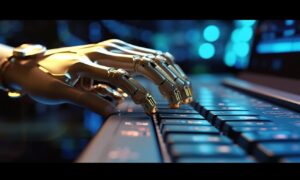Years ago, artists were seen as a bunch of lone wolves who worked in their garages or dark rooms. That is no longer the case. Thanks to the power of generative AI, creative work is becoming more and more collaborative. This is a huge shift for the creative industry, as it opens up new opportunities for both artists and businesses alike. In this blog post, we will explore how generative AI is changing creative work and what businesses can do to take advantage of these changes.
What Is Generative AI?
As people increasingly rely on artificial intelligence to help with their day-to-day tasks, the technology is also beginning to change the way we approach creativity and problem solving. Generative AI has been used by companies such as Google, Facebook, and Twitter to create new content and services, but its potential impact goes beyond commercial applications. Researchers are now exploring how generative AI can be used to generate new ideas or solutions for problems that have never been faced before.
One of the most promising applications of generative AI is in the field of music composition. By using machine learning algorithms to generate unique melodies, musicians can explore uncharted territory and create sounds that have never been heard before. In addition to creating new pieces of music, this approach can also be used to generate new ways to play existing pieces or remix existing songs. This is according to Andrew Tsionas, co-founder of Kaizenzo.
Another area where generative AI is having a profound impact is in visualization. By generating random data sets, researchers can create 3D models that are impossible to produce using traditional methods. This technology has already been used by companies such as Google Maps and GE Aviation to create realistic images of landscapes and aircrafts, respectively.
Overall, there are endless possibilities for how generative AI can be used to improve our lives and work processes. As the technology evolves and becomes more advanced, we may see even more dramatic changes in the way we think about creativity and problem solving
Marketing Applications
“Creative work is constantly in flux, as new technologies and methods are introduced to the field. With generative AI, this flux is being actively channeled and manipulated by machines, leading to some exciting changes for creative professionals”, says Ken Adams, CEO & Founder of Full of Sports.
One such change is the increasing use of machine learning algorithms to create art. By pairing a machine’s ability to learn from data with human creativity and intuition, it is possible to produce pieces that are more accurate and realistic than ever before. This has opened up opportunities for artists who may not have been able to compete with traditional methods, as well as allowing for new avenues of artistic expression that were not possible before.
Another application of generative AI in the marketing realm is its use in content generation. By using algorithms that mimic how people process information, marketers can create content that is more engaging and interactive. This type of content can be used in a number of ways, including by automatically generating ads based on user behavior or by creating user profiles that help generate targeted content.
Overall, these are just a few examples of how generative AI is changing creative work across various industries. As technology continues to evolve, there are sure to be even more transformative changes taking place in the world of creativity!
Code Generation Applications
Code generation is a process by which software can be automatically generated from a specification. This enables developers to create code for a project without needing to write it from scratch. Code generation applications can be used in a variety of fields, such as software development and engineering, product design, and scientific computing.
Code generation has been used in industry for some time now, but its use in the creative field is growing rapidly. Code generation applications are being used more commonly to create solutions that do not require human input. One example is machine learning algorithms that generate solutions to problems using data sets. These algorithms can be trained on large data sets, and then used to solve specific problems without requiring any human input.
Another application of code generation is in the creation of digital products. Digital products are created using technologies such as 3D printing, laser cutting, and CAD software. These products often require customization or modification before they are released to the public. Code generation applications can help speed up the process of creating these products by automating certain steps.
Code generation also has uses in scientific computing. Scientific computing involves the use of codes that allow mathematicians to solve problems faster than they could with traditional methods. Codegeneration applications allow scientists to create custom codes that can solve specific problems quickly and easily. Thanks to Alex Federo, co-owner of FTW Concrete Contractors.
Conversational Applications
The ability to generate new ideas is fundamental to creativity, and generative AI is helping to change that. By harnessing the power of machine learning, generative AI can create new pieces of art, designs, or conversations. This technology is already being used in a number of creative industries, such as advertising and music composition.
One example of how generative AI is being used in creative work is in Advertising. A company called Lift recently released an ad that was generated using machine learning. The ad was created by training a computer model on millions of images from different ads and then using that data to create a new ad. The end result was an incredibly realistic ad that blends the original imagery with newer elements.
Another example of how generative AI is changing creative work comes from music composition. Several composers are using machine learning to create unique soundtracks for movies and video games. For instance, David Cope uses machine learning to create unique scores for movie trailers. He says that this type of work gives him more control over the final product and allows him to explore different sounds and themes without having to worry about traditional music genres or rules.
Overall, the use of generative AI is changing the way we think about creativity and its relation to technology. By allowing machines to generate new ideas on their own, we are unlocking greater potential in our creative abilities. This is thanks to Smithe Sodine, founder of Smithy Home Couture.
Knowledge Management Applications
“Knowledge management (KM) applications are used by organizations to manage, track, and share knowledge within the organization. KM applications allow users to search for information, create and manage documents, and collaborate on projects. Generative AI can be used to automate the process of knowledge creation and management”, says Jeremiah Erasga, content director of Flightradar Online.
It can be used to automatically generate reports, documents, or content. This could be used to create documentation for a product or service, or to generate marketing material for a company. It can also be used to create new content for an existing website. Generative AI can help users find information quickly. This could be useful when creating documentation or when trying to find information about a new product.
The use of generative algorithms has the potential to change the way we think about KM applications. Generative AI allows us to create new versions of documents as we encounter problems or new insights.
Deepfakes and Other Legal/Ethical Concerns
As deepfakes and other generative AI technologies continue to evolve, more people are becoming aware of the legal and ethical concerns that come with their use. For example, deep fakes could be used to create fake porn videos that are indistinguishable from the real thing. This could have serious implications for both the pornography industry and the privacy of individuals who are featured in these videos.
Another potential concern is that deep fakes could be used to create doctored footage of political leaders or celebrities. If this footage were to become publicly available, it could seriously undermine the credibility of those individuals. In addition, such doctored footage could also be used to discredit political movements or causes.
There are also ethical concerns surrounding the development of artificial intelligence that can generate realistic images. For example, if an AI is designed to generate realistic images of people, it may be able to replicate some aspect of a person’s personality (for example, their facial expressions). This raises questions about what kind of information should be allowed into an AI’s “memory” (i.e., its capability to generate realistic images), and whether or not such information should be accessible by humans.



































